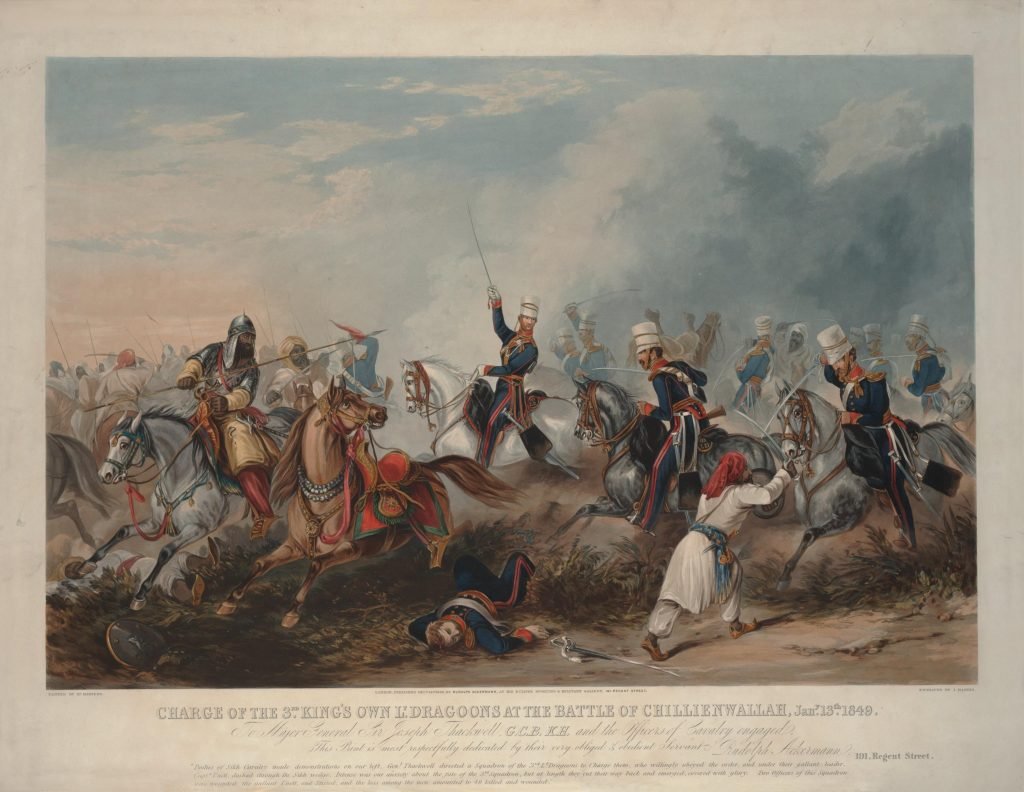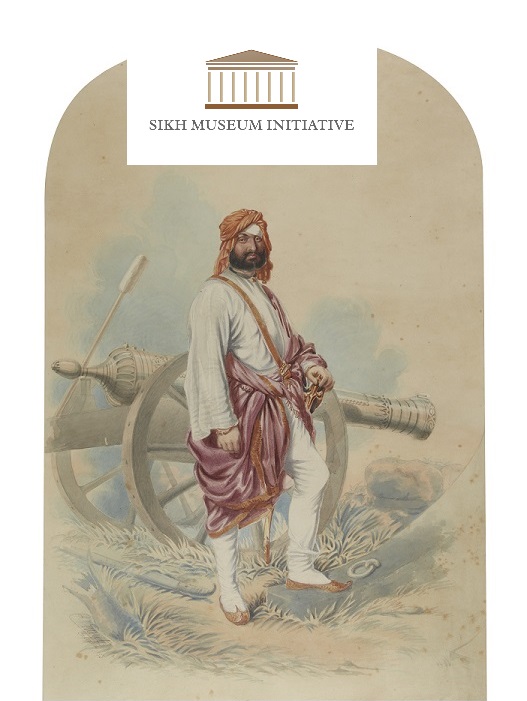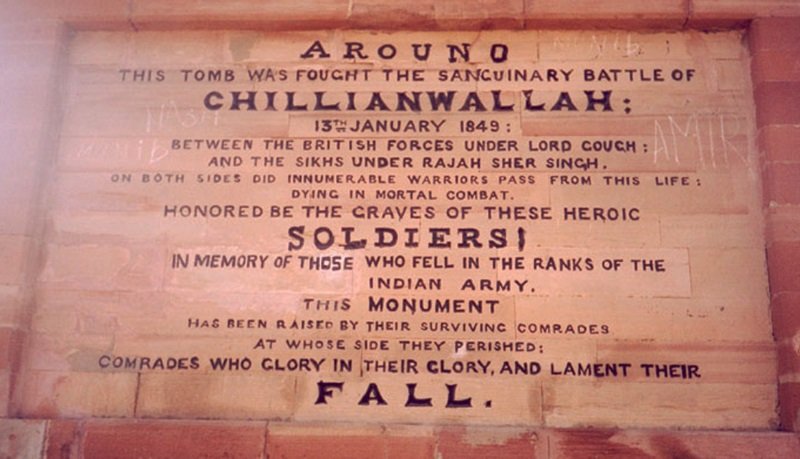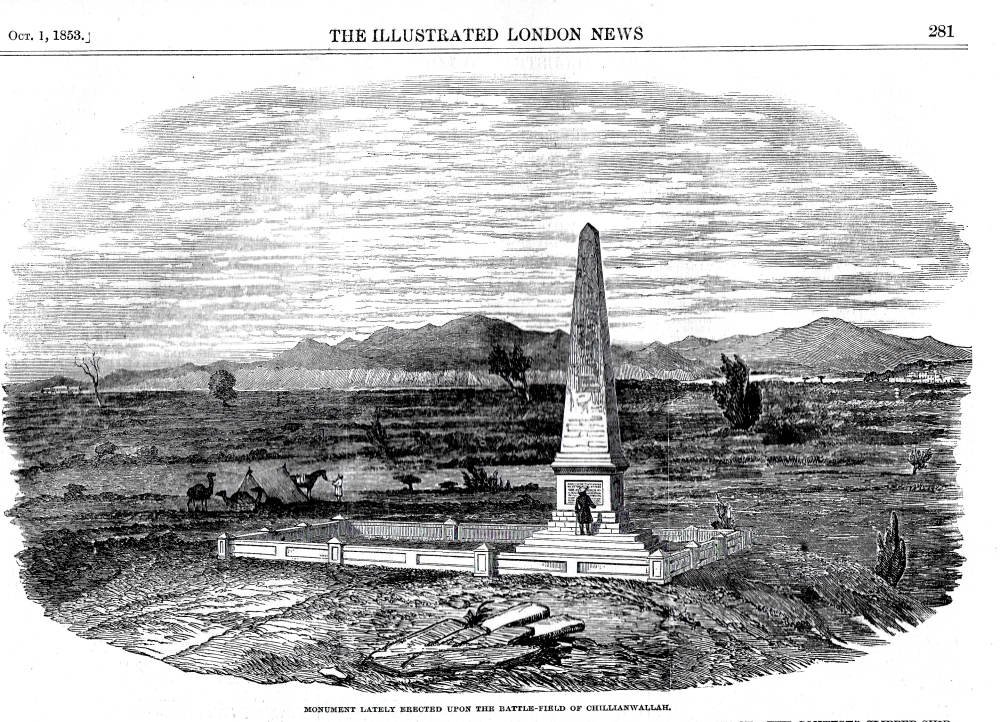
Led by Captain Unett, the charge of the 3rd Kings Dragoons at the Battle of Chillianwallah, Jan 13th 1849. By J Harris after H Martens, 1849, published by R Ackermann.
Hugh Gough awaited further instructions from the Governor General Dalhousie after the Battle at Ramnuggar. Early in January 1849, news came that the British had recaptured the city of Multan (although Mulraj still defended the citadel), but also that the Muslim garrison of Attock had defected to Amir Dost Mohammad Khan of Afghanistan, who was half-heartedly supporting Chattar Singh. The fall of Attock nevertheless allowed Chattar Singh’s army to leave Hazara and move south. Dalhousie ordered Gough to seek out and destroy Sher Singh’s main army before the Sikh armies could combine, without waiting for reinforcements from the army at Multan.
Engagement at Chillianwallah
On 13 January, Gough’s army was marching towards the reported Sikh position at Rasul, on the left bank of the Jhelum River, about 85 miles (137 km) north-west of Lahore. At noon, they drove a Sikh outpost out of the village of Chillianwallah. At this point, Gough intended to march round to the north of the Sikh position and attack its left flank on the following day, but from the vantage point of a mound near Chillianwallah, it was apparent that the Sikhs had advanced from their original positions along ridges close to the Jhelum. Sher Singh’s army had originally occupied a position six miles long, too extended for their numbers and vulnerable to a flank attack such as Gough proposed. By advancing, Sher Singh made a British flank march too risky and forced the British to make a frontal attack.
The Sikh army consisted of three main bodies of troops.On the left under Sher Singh himself were one cavalry regiment, nine infantry battalions, some irregulars and 20 guns, occupying some low hills and ridges. In the centre under Lal Singh and Attar Singh were two cavalry regiments, ten infantry battalions and 17 guns, mostly concealed in or behind belts of scrub and jungle. On the right was a brigade which formerly had garrisoned Bannu, under Ram Singh consisting of one cavalry regiment, four infantry battalions and eleven guns, anchored on two villages. Other irregulars extended Sher Singh’s left flank. Sher Singh displayed exceptional skill by judiciously selecting his position which was protected on the left by a low ridge of hills intersected with ravines and the main stream of the Jhelum, the right being posted in different villages enclosed by a thick jungle.
Gough’s army was composed of two infantry divisions, each of two brigades, each in turn of one British and two Bengal Native infantry battalions, with a total of 66 guns from the Bengal Artillery and Bengal Horse Artillery. The 3rd Division under Sir Colin Campbell, with two field artillery batteries and three horse artillery troops, was deployed on the left, while the 2nd Division commanded by Major General Sir Walter Gilbert was deployed on the right with a field artillery battery and three horse artillery troops. Gough also had a cavalry division under Major General Joseph Thackwell, but this was split, with one brigade on each flank; Brigadier White’s on the left, Brigadier Pope’s on the right. Gough deployed two heavy artillery batteries with eight 18-pounder guns and four 8-inch howitzers in the centre. A brigade of Bengal Native troops under Brigadier Penney was in reserve.

Depiction of Raja Sher Singh Attariwala. C. Grant / Calcutta / 1853
The battle
Gough ordered the advance to commence at about 3:00 pm. From the outset, the right-hand brigade of Campbell’s division, commanded by Brigadier Pennycuick, was in difficulties. Because the jungle made it difficult for Campbell to coordinate his two brigades, he assumed personal command of the left hand brigade under Brigadier Hoggan, while ordering Pennycuick to attack with the bayonet. The British regiment of Pennycuick’s brigade was the 24th Foot, which had only recently arrived in India. They advanced very rapidly, but lost cohesion and also lost touch with the rest of the brigade in the thick scrub. Trying to attack Sikh guns head-on, they suffered heavily from grapeshot. The regiment was ordered to engage the Sikh artillery battery at bayonet point, they were shot to pieces, losing over 500 officers and men. When they reached the main Sikh positions, Sikh resistance was desperate and the 24th were driven back. The Regiment colours – the focus of regimental pride and symbol of their allegiance to the Queen – were lost on the battlefield. Pennycuick’s brigade eventually became completely disorganised and had to make its way back to the start line in small parties. Pennycuick himself was killed.
Campbell’s left hand brigade (under Brigadier Hoggan and Campbell himself) had greater success. The 61st Foot captured several guns and even an elephant, and Brigadier White’s cavalry followed up with an effective charge. Hoggan’s troops eventually met the left-hand brigade of Gilbert’s division, commanded by Brigadier Mountain, behind the Sikhs’ centre positions.On Gough’s right however, his troops had met with disaster. While Gilbert’s two brigades had at first successfully driven the Sikhs before them, capturing or spiking several guns, on their right flank, Brigadier Pope (who was almost an invalid) first ordered an ineffective cavalry charge through thorn scrub which threw his brigade into confusion, and then panicked and ordered a retreat. One of his British cavalry regiments, the 14th Light Dragoons, routed. The Sikhs followed up the fleeing cavalry and captured four guns. They then attacked Gilbert’s right-hand infantry brigade, commanded by Brigadier Godby, from the rear, forcing him to withdraw under heavy pressure until Penney’s reserve brigade came to his aid.
A testimony left by a British observer says:
The Sikhs fought like devils, fierce and untamed… Such a mass of men I never set eyes on and as plucky as lions: they ran right on the bayonets and struck their assailants when they were transfixed
By now, darkness was approaching with some of his formations rendered ineffective, or having to fight their way out of encirclement, Gough ordered a withdrawal to the start line. Although his units brought back as many wounded as they could, many of them could not be found in the scrub. Many of the abandoned wounded were killed during the night by roving Sikh irregulars. Gough’s retreat also allowed the Sikhs to recapture all but twelve of the guns the British had taken earlier in the day.
The final losses to Gough’s army were 757 killed, 1,651 wounded and 104 missing for a total of 2,512. A comparatively high proportion of the casualties (almost 1,000) were British rather than native Indian. This was mainly a result of the disaster which befell the 24th Foot, which suffered 590 casualties, over 50 percent. Sikh casualties were estimated at 4,000 dead and wounded. Gough was criticised for his handling of the battle, and was relieved of command and was superseded by General Charles James Napier.

Around this Tomb was Fought the sanguinary Battle of Chillianwallah, 13th Jan., 1849 ; between the British forces, under Lord Gough, and the Sikhs, under Rajah Sher Singh; on both sides did innumerable Warriors pass from this life, dying in mortal combat. Honoured be the graves of those heroic Soldiers! To the Memory of those who fell in the ranks of the Anglo-Indian Army, this Monument has been raised, by their surviving comrades, at whose sides they perished: comrades who glory in their glory, and lament their fail.
Facts about the battle
The Chillianwallah Battle was fought in almost the same area where Porus, with his elephants, chariots and archers, had fought Alexander the Great’s cavalry.
Both armies held their positions at the end of the battle and Sher Singh withdrew to the north. The Sikhs claimed that they forced the British to retreat but the British forces actually withdrew three days after the battle ended; however, this was due to the rains which separated the two armies for that duration.
The repulse of the British, together with the loss of several guns and the colours of the 24th and two other regiments, and the rout of the 14th Light Dragoons, dealt a blow to British morale and is testament to the tenacity and martial skill of the Sikh army.
Chillianwallah bears similarities to the Battle of Ferozeshah (First Anglo Sikh War) where the British Empire hung in the balance.

